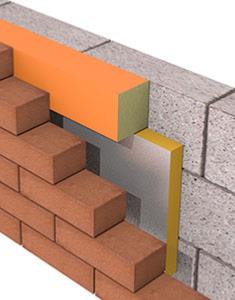
A cavity fire barrier for masonry construction
» Up to four hours fire integrity
» Specified in semi-detached, apartments and major projects
» Complies to Robust Detail Part E and Building Regulations
» Easy to install
Available in a choice of two sizes:-
| 120 x 100 x 1200mm |
Suitable for a Cavity Width of 100mm |
Masonry Fire Rating 4 hours |
| 160 x 120 x 1200mm |
Suitable for a Cavity Width of 150mm |
Masonry Fire Rating 4 hours |
Application
A Cavity Stop Sock restricts the spread of smoke and flames within external masonry walls, as well as minimising the effect of flanking noise pollution at wall junctions. They are manufactured from low resin, non-combustible rockfibre mineral wool insulation and are sleeved in polythene for on-site protection.
Installation
A Cavity Stop Sock is designed to be compression fitted within a masonry cavity as the brick and block work progresses, no mechanical fixing is required. Care should be taken to ensure butt joints are tightly fitted with no gaps remaining. The barrier must fully fill the cavity from brick to block, with any cavity insulation cut back. The polythene encapsulation offers on-site weather protection, but can be cut away without affecting the barrier’s performance.
Fire Properties
These Cavity Stop Socks have been fire tested at Warrington Fire Research, achieving up to four hours fire integrity with traditional masonry brick and block construction. These tests comply with BS 476: Part 20: 1987 and BSEN 1366-4: 2006, using the test method stated EGOLF TC2 N421 (fire resistance for cavity barriers). Certifire scope: CF5403
Where usage falls outside of this scope, for example when used with external cladding, or with an internal metal frame system, performance of the fire barrier will depend upon the structural integrity and fire performance of the surrounding construction.
Specifiers must ensure any part of the construction that makes up the internal or external leaf of the wall, including support systems, are suitable for use with a fire barrier for the length of fire integrity and insulation required. Particular attention must be paid to any possible deflection or distortion which could cause gaps to form between the material and a fire barrier.
|







